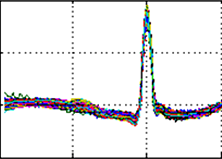Analysis of electrocardiosignals for formation of the diagnostic features of post-traumatic myocardial dystrophy
DOI:
https://doi.org/10.3103/S0735272717090047Keywords:
HR ECG, post-traumatic myocardial dystrophy, wavelet analysis, eigenvector basis, principal component analysisAbstract
The possibilities of high-resolution electrocardiography (HR ECG) application for diagnostics of post-traumatic myocardial dystrophy having multifactorial genesis is considered in this paper. Numerical processing and analysis of electrocardiograms that belong to patients from armed forces after explosive-driven injuries have been performed based on clinical studies. Complex method of cardiosignal analysis based on combination of wavelet analysis, eigenvector decomposition and principal component analysis is developed. This method revealed that low-amplitude deviations in ECG signal in case of post-traumatic myocardial dystrophy have low-frequency nature that is linked to slow electro-physiological processes. It is shown that these low-frequency, low-amplitude components appear at a high levels (8th and 9th) of decomposition in case of 9-level wavelet decomposition of averaged cardio cycles. Integral parameters for identification of post-traumatic myocardial dystrophy features are suggested and determined on the basis of principal component analysis. These parameters are squared sum of signal projections to eigenspaces Hk and mean eigenvalues of covariance matrices of electrocardiosignals ensembles λmean.References
- KHAZAIE, H.; SAIDI, M.R.; SEPEHRY, A.A.; KNIGHT, D.C.; AHMADI, M.; NAJAFI, F.; PARVIZI, A.A.; SAMADZADEH, S.; TAHMASIAN, M. Abnormal ECG patterns in chronic post-war PTSD patients: a pilot study. Int. J. Behav. Med., v.20, No. 1, p.1-6, 2013. DOI: http://doi.org/10.1007/s12529-011-9197-y.
- İLHAN, E.; KAPLAN, A.; GÜVENÇ, T.S.; BITEKER, M.; KARABULUT, E.; IŞIKLI, S. Electrocardiographic features of patients with earthquake related posttraumatic stress disorder. World J. Cardiol., v.5, No. 3, p.60-64, 2013. DOI: http://dx.doi.org/10.4330/wjc.v5.i3.60.
- ISAEVA, A.D. Myocardial dystrophy. Reasons, symptoms, features, diagnostics and treatment of pathology. URI: http://www.polismed.com/articles-miokardiodistrofija-prichiny-simptomy-priznaki.html.
- GUMANENKO, Y.K. (ed.). Military-Field Surgery [in Russian], 2nd ed. Moscow: GEOTAR-Media, 2008. URI: http://www.studmedlib.ru/book/ISBN9785970409114.html.
- IVANUSHKINA, N.G.; IVANKO, K.O. Digital Processing of Low Amplitude Components of Electrocardiosignal [in Ukrainian]. Mykolaiv, 2014.
- RANGAYYAN, R.M. Biomedical Signal Analysis. A Case-Study Approach. Wiley-IEEE Press, 2001.
- IVANUSHKINA, N.; CHESNOKOVA, O.; IVANKO, K.; KARPLYUK, Y.; CHAIKOVSKIY, I.; SOFIENKO, S.; MJASNIKOV, G. Formation of the diagnostic HR ECG features of post-traumatic myocardial dystrophy. Proc. of 2016 IEEE 36th Int. Conf. on Electronics and Nanotechnology, ELNANO, 19-21 Apr. 2016, Kyiv, Ukraine. IEEE, 2016, pp. 206-209. DOI: http://doi.org/10.1109/ELNANO.2016.7493049.
- IVANUSHKINA, N.G.; IVAN'KO, E.O.; CHESNOKOVA, O.V.; CHAIKOVSKII, I.A. Wavelet analysis of the electrocardioignals for detection of the posttraumatic myocardial dystrophy features. Bulletin of National Technical University of Ukraine. Series Radiotechnique. Radioapparatus Building, No. 65, p. 90-98, 2016. URI: http://radap.kpi.ua/radiotechnique/article/view/1221.
- SEENA, V.; YOMAS, J. A review on feature extraction and denoising of ECG signal using wavelet transform. Proc. of 2014 2nd Int. Conf. on Devices, Circuits and Systems, ICDCS, 6-8 Mar. 2014, Combiatore, India. IEEE, 2014, p. 1-6. DOI: http://doi.org/10.1109/ICDCSyst.2014.6926190.
- HAQUE, A.K.; ALI, M.H.; KIBER, M.A.; HASAN, M.T. Detection of small variations of ECG features using wavelet. ARPN J. Eng. Appl. Sci., v.4, No. 6, p. 27-30, 2009. URI: http://www.arpnjournals.com/jeas/research_papers/rp_2009/jeas_0809_223.pdf.
- CASTELLS, F.; LAGUNA, P.; SÖRNMO, L.; BOLLMANN, Andreas; ROIG, J.M. Principal component analysis in ECG signal processing. EURASIP J. Adv. Signal Process., v.2007, Article ID 74580, 21 pages, 2007. DOI: http://doi.org/10.1155/2007/74580.
- MARTIS, Roshan Joy; ACHARYA, U. Rajendra; MANDANA, K.M.; RAY, A.K.; CHAKRABORTY, Chandan. Application of principal component analysis to ECG signals for automated diagnosis of cardiac health. Expert Systems with Applications, v.39, No. 14, p. 11792-11800, 2012. DOI: http://doi.org/10.1016/j.eswa.2012.04.072.

Downloads
Published
2017-09-21
Issue
Section
Research Articles

